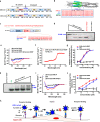Fusion mechanism of 2019-nCoV and fusion inhibitors targeting HR1 domain in spike protein
- PMID: 32047258
- PMCID: PMC7075278
- DOI: 10.1038/s41423-020-0374-2
Fusion mechanism of 2019-nCoV and fusion inhibitors targeting HR1 domain in spike protein
Conflict of interest statement
The authors declare no competing interests.
Figures

Similar articles
-
Design of Potent Membrane Fusion Inhibitors against SARS-CoV-2, an Emerging Coronavirus with High Fusogenic Activity.J Virol. 2020 Jul 1;94(14):e00635-20. doi: 10.1128/JVI.00635-20. Print 2020 Jul 1. J Virol. 2020. PMID: 32376627 Free PMC article.
-
Structural and functional properties of SARS-CoV-2 spike protein: potential antivirus drug development for COVID-19.Acta Pharmacol Sin. 2020 Sep;41(9):1141-1149. doi: 10.1038/s41401-020-0485-4. Epub 2020 Aug 3. Acta Pharmacol Sin. 2020. PMID: 32747721 Free PMC article. Review.
-
Inhibition of Coronavirus Entry In Vitro and Ex Vivo by a Lipid-Conjugated Peptide Derived from the SARS-CoV-2 Spike Glycoprotein HRC Domain.mBio. 2020 Oct 20;11(5):e01935-20. doi: 10.1128/mBio.01935-20. mBio. 2020. PMID: 33082259 Free PMC article.
-
Targeting the SARS-CoV-2 spike glycoprotein prefusion conformation: virtual screening and molecular dynamics simulations applied to the identification of potential fusion inhibitors.Virus Res. 2020 Sep;286:198068. doi: 10.1016/j.virusres.2020.198068. Epub 2020 Jun 18. Virus Res. 2020. PMID: 32565126 Free PMC article.
-
Coronavirus membrane fusion mechanism offers a potential target for antiviral development.Antiviral Res. 2020 Jun;178:104792. doi: 10.1016/j.antiviral.2020.104792. Epub 2020 Apr 6. Antiviral Res. 2020. PMID: 32272173 Free PMC article. Review.
Cited by
-
Immunity and Coagulation in COVID-19.Int J Mol Sci. 2024 Oct 19;25(20):11267. doi: 10.3390/ijms252011267. Int J Mol Sci. 2024. PMID: 39457048 Free PMC article. Review.
-
Advancements in the Development of Anti-SARS-CoV-2 Therapeutics.Int J Mol Sci. 2024 Oct 9;25(19):10820. doi: 10.3390/ijms251910820. Int J Mol Sci. 2024. PMID: 39409149 Free PMC article. Review.
-
In Vitro Profiling of the Antiviral Peptide TAT-I24.Int J Mol Sci. 2024 Sep 28;25(19):10463. doi: 10.3390/ijms251910463. Int J Mol Sci. 2024. PMID: 39408791 Free PMC article.
-
Study of Potential Blocking Peptides Targeting the SARS-CoV-2 RBD/hACE2 Interaction.Pharmaceuticals (Basel). 2024 Sep 20;17(9):1240. doi: 10.3390/ph17091240. Pharmaceuticals (Basel). 2024. PMID: 39338402 Free PMC article.
-
Insight into genomic organization of pathogenic coronaviruses, SARS-CoV-2: Implication for emergence of new variants, laboratory diagnosis and treatment options.Front Mol Med. 2022 Oct 17;2:917201. doi: 10.3389/fmmed.2022.917201. eCollection 2022. Front Mol Med. 2022. PMID: 39157715 Free PMC article. Review.
References
MeSH terms
Substances
Grants and funding
- 81672019/National Natural Science Foundation of China (National Science Foundation of China)/International
- 81822045/National Natural Science Foundation of China (National Science Foundation of China)/International
- 81703571/National Natural Science Foundation of China (National Science Foundation of China)/International
- 81630090/National Natural Science Foundation of China (National Science Foundation of China)/International
LinkOut - more resources
Full Text Sources
Other Literature Sources

